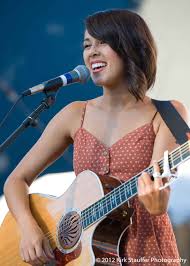There’s something deeply satisfying about a song that takes you somewhere.
Not just in terms of the notes or the lyrics - but in how it feels to go on the journey to a destination.
A good song doesn’t just sit in one emotional place.
It moves, it grows, it develops.
And as the singer, YOU get to bring that to life.
Why Do We Sing, Really?
Let’s start here.
Why do we even sing in the first place?
When I’ve asked students this in the group courses I’ve run, I’ve heard things like:
- To tell a story
- To share a feeling
- To create atmosphere
- To connect
- To celebrate
- To offer something meaningful
And when you put all that together, it’s really about giving people an experience.
A journey they can feel in their body and emotions, not just understand with their mind.
Songs Have a Natural Flow - Do You Notice It?
Here’s something I love to show students when we talk about performance and energy.

This is the emotional shape of a typical modern song - pop, soul, musical theatre, funk, blues… They don’t all follow it exactly, but most of them ride these same waves.
You’ve got:
- Versesthat set the scene and tell the ‘chapters’ of the story
- Chorusesthat show you the main feeling or message of the song
- A bridgethat adds contrast or a new perspective on the story and its message
- Then a final chorus and ending that takes you high on the vibe and then gently brings you back down to the ground.
The energy rises and dips in increasing waves… builds… peaks… then resolves.
It’s designed to be satisfying. You feel the build, the payoff, the release.
But the thing is:
👉A song can have this structure and still fall flat... if the singer doesn’t live, and express, that journey.
Your Voice Is the Vehicle
You don’t need to act, or “perform” in some fake way.
But it really helps to feel where you are in the shape and journey of the song.
Think of it like this:
- The first verse is the starting scenario, and usually the lowest point in the story, so you’ll often need to sing quietly here, while hooking people in through a genuine connection to the meaning.
- The chorus lifts us - maybe there’s more volume, more richness of tone
- The bridge gives a different angle – so maybe use a slightly different voice quality to reflect that
- The final chorus—this is the peak moment. It usually needs power, energy, vibrance.
That doesn’t mean it has to be big and belty. It just has to mean something.
People can feel when it does.
You Can Build the Energy in Lots of Ways
You don’t have to rely on just one tool. Here are some ways singers shape the energy:
- Letting your tone become brighter, more intense or more powerful in the chorus
- Varying your dynamics (soft to loud… or loud to soft)
- Changing your tone quality to reflect different emotions
- Adding space between phrases to let something land
- Even the tiniest pause can hold so much feeling
It’s about contrast and variety. It’s about singing in a way that supports the evolution of the song, rather than staying in one emotional gear the whole time.
An Invitation to Explore
Next time you sing a song - maybe one you know really well - try this:
Where are the low points and high points in this song?
Where’s the climb? Where’s the release?
What kind of energy does each section want from me?
Start noticing it. Start playing with it.
You don’t have to change everything overnight. But even small shifts can open up whole new layers of expression.
Singing Is Movement
This is the heart of it, really.
Singing is not just about sound, it’s about movement. Emotion that moves.
For you, and for the person listening.
It becomes so much more enjoyable, fascinating, fulfilling, when you start to work with songs in this way. When you take the time to get to know the songs you love in this deeper way.
So if something in this post resonates with you, maybe it’s time to ask:
What kind of journey do I want to take my listeners on?
And what kind of journey do I want to go on, too?
💛
If you’d like to explore how I can help you with this, you’re welcome to book in with me for a Free Consultation



